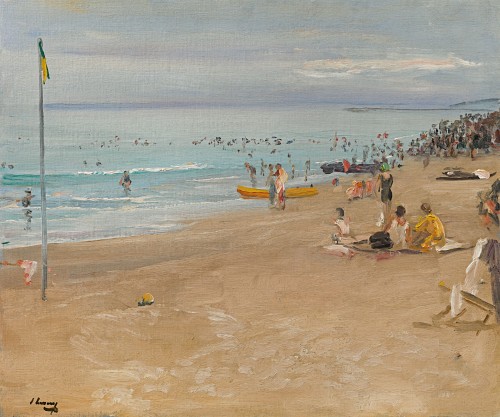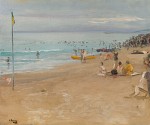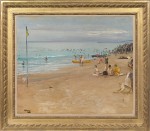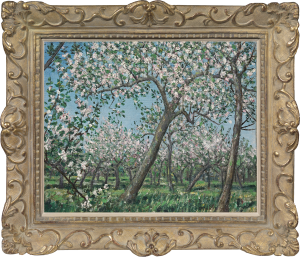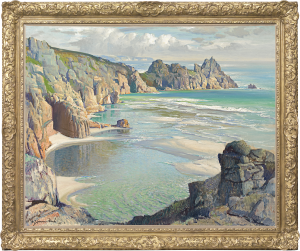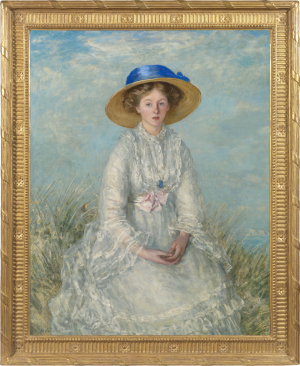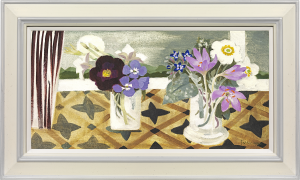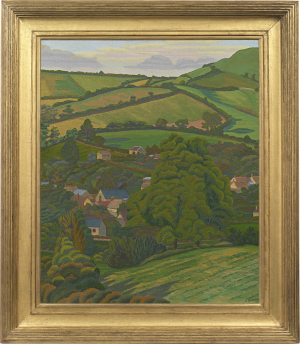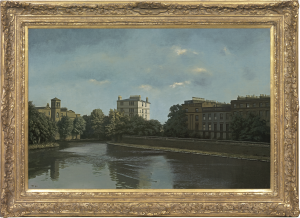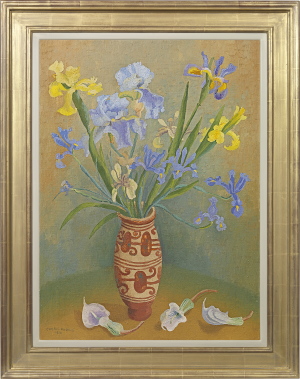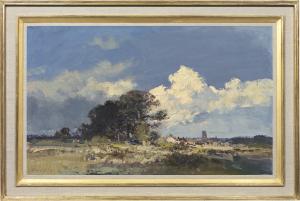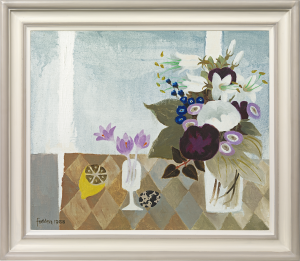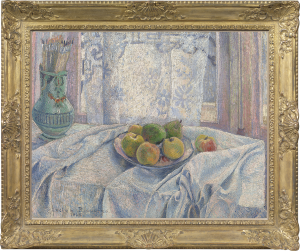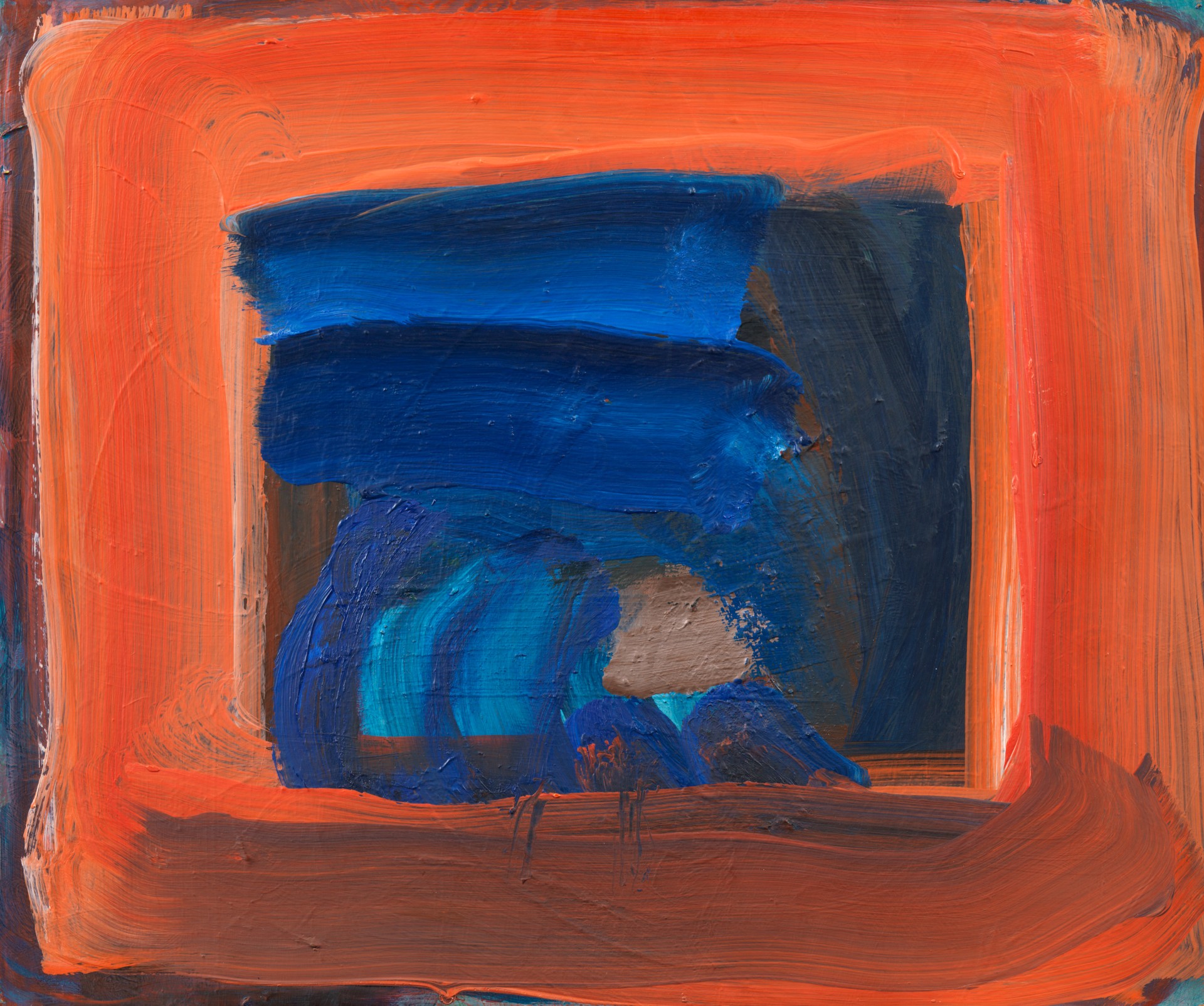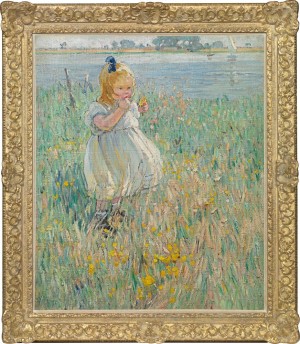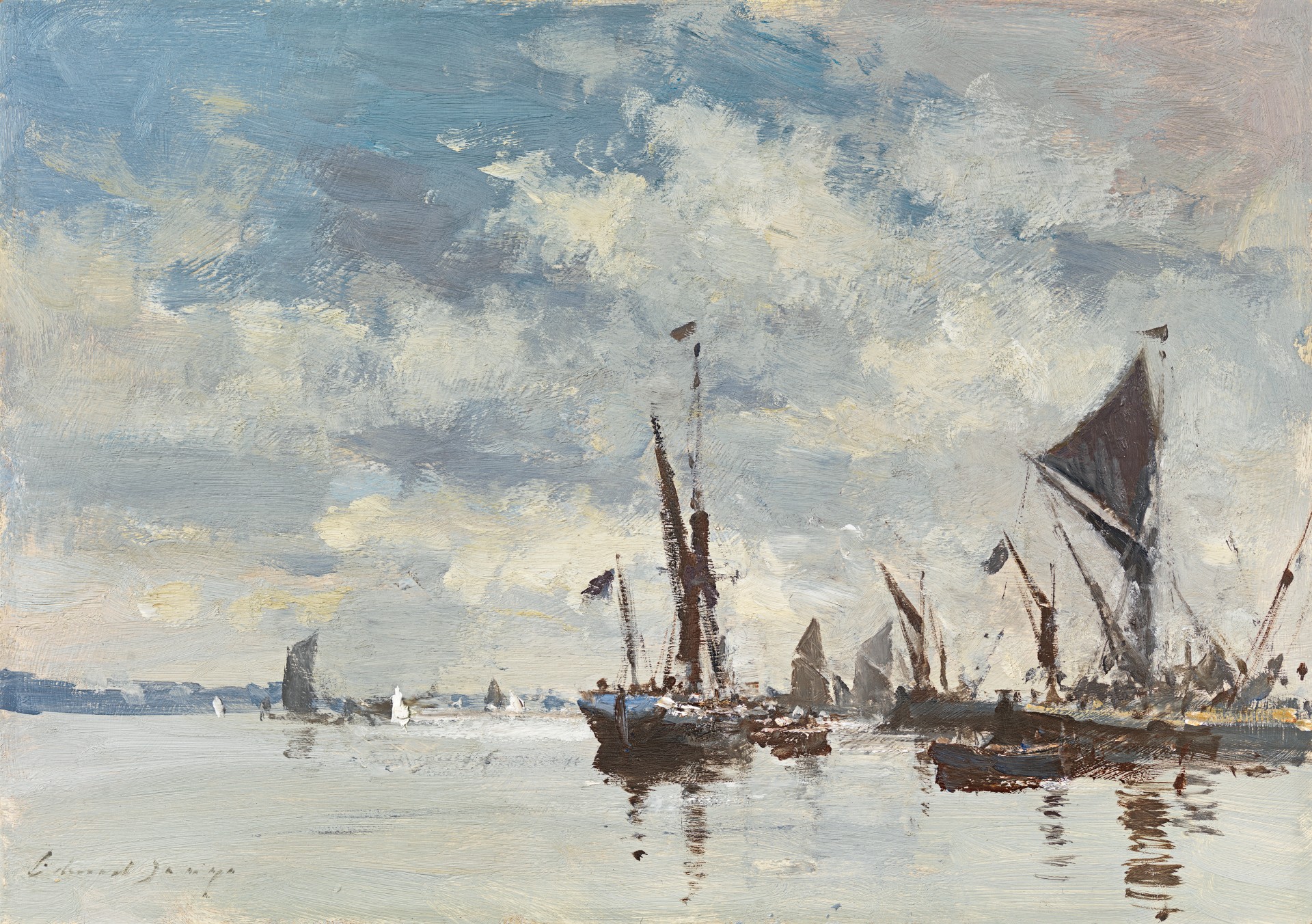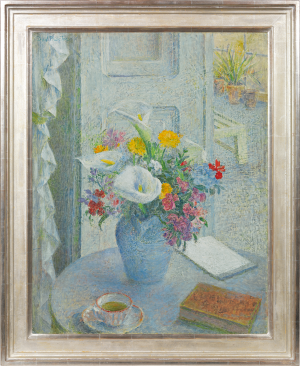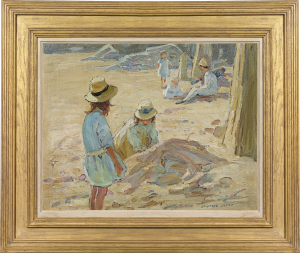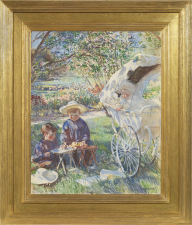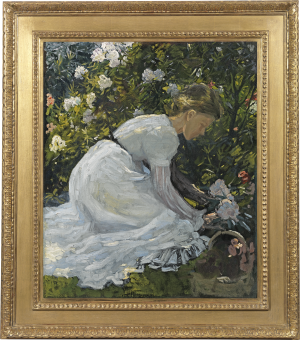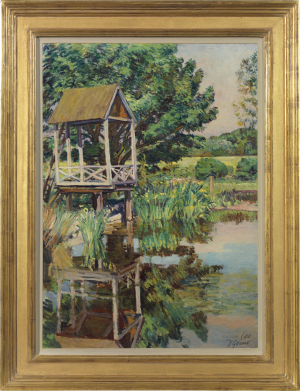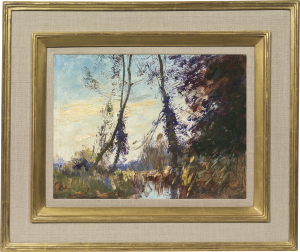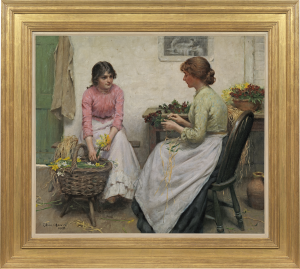Sir John Lavery
The Beach Deauville. Morning
Oil on board: 20 x 23.7 (in) / 50.8 x 60.3 (cm)
Signed lower left: J Lavery; signed, dated and inscribed on the reverse: The Beach Deauville. Morning / by John Lavery 1926
This artwork is for sale.
Please contact us on: +44 (0)20 7493 3939.
Email us
SIR JOHN LAVERY RA RSA PRP NP IS
Belfast 1856 - 1941 Kilmaganny, County Kilkenny
Ref: CB 105
The Beach, Deauville. Morning
Signed lower left: J Lavery; signed, dated and inscribed on the reverse: The Beach Deauville. Morning / by John Lavery 1926
Oil on board: 20 x 23 ¾ in / 50.8 x 60.3 cm
Frame size: 26 x 30 in / 66 x 76.2 cm
Provenance:
Ralph Beaver (1883-1959) & Mae Bourne Strassburger (1881-1975), Villa Strassburger, Deauville, then by descent to their son, Johann Andreas Peter Strassburger (1916-1993), Normandy Farm, Montgomery Co., Pennsylvania, then by descent
Throughout the twenties Sir John Lavery, newly knighted in 1918, spent parts of each summer in Ireland and Scotland. Early August was marked out for the Dublin Horse Show and golf at North Berwick as the guest of Sir Patrick and Lady Ford for the beginning of September. The pattern was largely unbroken save for 1926 when between the horse show and the East Lothian Links, he, his wife and stepdaughter took a short holiday at Deauville, where friends, Lord Derby, Lady Carlisle, the Duke of Westminster and the Mountbattens were staying.
Founded in ‘modern times as a sea-bathing resort’, according to Baedeker, Deauville, initially lacking in amenities, presented ‘the appearance of a half-filled canvas’ in the Edwardian years.[1] Since the war however, the town, a few miles south of the port of Le Havre, had overtaken its near neighbour, Trouville, in popularity as a holiday resort for the wealthy. Favoured by English and American visitors, it sported its own casino, promenade, ‘Roman Baths’ and adjacent racecourse, as well as the Grand Hotel Normandy, where the Laverys stayed.[2]
By the summer of 1926, Deauville was constantly in the news – particularly for the willingness of women visitors to forsake Lido pyjamas and don the so-called ‘simple swimmer’, or ‘wear American “vest and shorts” in blue or scarlet and white, completed with trim little belts of sealskin.’[3] One such is clearly visible in the present picture. Men, were, of course, similarly attired, but strictly forbidden to remove their vests while sunbathing.[4] This year’s novelty was André Citrëon’s ‘caterpillar motor tractor from the Desert of the Sahara’ that provided beach rides for children.[5] Elsewhere, hotels laid on 3.00pm breakfasts for all-night revellers while a wireless appeared on the plage to facilitate the latest dance craze (fig 1).
Fig 1 ‘Dancing to Wireless on Deauville Plage: Mlle Camarys, of the
Théâtre de la Madeleine’, from The Sketch, 25th August 1926, p.152.
While it is unlikely that the painter indulged, during that month, his social calendar was full. In the preceding weeks he had been guest of the Irish Governor General, Tim Healy at Vice-Regal Lodge in Phoenix Park, Dublin, where other guests included the Kenmares, the Powerscourts, the Maharajah of Alwar and the Jam of Nawanagar. A quick turnaround in London and they were in Deauville by 16th August where one diarist wondered ‘will he be painting horses at the racecourse or lovely ladies in the Casino?’[6]
These subjects may well have appealed to Lavery, but it was the beach crowded with bathers that caught his eye. For the present canvas he would trudge away from the hubbub to obtain a clear view of the coastline stretching up to the long jetée promenade at the far end of the Trouville plage, just below the horizon on the right.
Lavery was no stranger to such subjects, his first beach scene having been painted on the Antrim coast in 1887. In the years to come he was of course aware of the work of Eugène Boudin, Claude Monet and the Impressionists who tackled such subjects, and during his ten years as Vice-President of the International Society of Sculptors, Painters and Gravers he had the opportunity to work closely with James McNeill Whistler, hanging one or two of his early Trouville plage paintings (fig 2).[7] Tangier, and the pellucid ‘Southern Sea’ then intervened – as did seascape series at St Jean de Luz in 1917 and the Bay of Tunis in 1919 (fig 3).
Fig 2 James McNeill Whistler, Blue and Silver: Fig 3 John Lavery, The Southern Sea, 1910,
Trouville, 1865, Freer Gallery of Art, Washington DC Richard Green Gallery
None, however, was so populous as the present picture, where mastery is revealed in the notation of figures in one or two strokes of a loaded brush. Examine these and one finds not only fashionable ‘simple swimmers’ but someone wrapped in a towel, as well as deckchairs and other paraphernalia recorded in a free and lively manner. Hedonism, holiday high jinks nevertheless, take second place to the rippling tide, touched with emerald and pale blue-greys from a sultry sky that brilliantly trap the late summer light of La Manche.[8]
Kenneth McConkey, author of Sir John Lavery, a painter and his world, 2010 and curator of the forthcoming exhibition, John Lavery – On Location at the National Gallery of Ireland, Ulster Museum and the National Gallery of Scotland, 2023-24
Note on provenance: Ralph Beaver (1883-1959) & Mae Bourne Strassburger (1881-1975)
Ralph Beaver Strassburger, born in Norristown, Pennsylvania, was an American business tycoon, a Naval Officer, a politician, a genealogist and a Newspaper proprietor, as well as being a thoroughbred racecourse owner and breeder. He studied at Phillips Exeter Academy, New Hampshire before joining the United States Naval Academy, graduating in 1905 and serving in the Navy until 1909. In 1911 Ralph married Mae Bourne, the daughter of Frederick Gilbert Bourne, president of the Singer Sewing Machine Company, at West Wickham, Kent before driving through Normandy on their honeymoon, which sparked a lifelong passion for the area. In 1914 he was an unsuccessful candidate for the United States House of Representatives and served as a delegate to the Republican National Convention in 1936.
Strassburger rejoined the Navy serving as a transport officer following America’s entry into the First World War and was discharged in 1919. In 1921 he entered the newspaper business in his hometown, acquiring the Herald and in 1922, the Times, merging the papers to create the Norristown Times Herald, which is still published today. He also wrote and published books relating including, Pennsylvania German Pioneers: a publication of the original lists of arrival in the Port of Philadelphia from 1727 to 1808, in 1934. He was president of the Pennsylvania German Society from 1928 to 1940.
The Strassburgers owned several properties in America, including Normandy Farm in Pennsylvania, purchased in 1913, named after the area of France which they loved and which was renowned for its important horse farms. In 1924 Ralph and Mae purchased a Villa in Deauville built in 1907 for Baron Henri de Rothschild. Villa Strassburger was bequeathed to the City of Deauville in 1980 by their son, Johanne Andreas Peter Strassburger. They also acquired the Haras des Monceaux Thoroughbred horse farm at Lisieux and enjoyed considerable success at the Deauville-Touques Racecourse.
Paintings and antiques from the Strassburgers collection were gifted by their descents to the Philadelphia Museum of Art.
SIR JOHN LAVERY RA, RSA, PRP, NP, IS
Belfast 1856 - 1941 Kilmaganny, County Kilkenny
It has been claimed that Sir John Lavery belonged to the Glasgow School, the Ulster School, the Irish School and the British School, indicating the versatility and wide-ranging appeal of his artistic accomplishments. His works are greatly admired for his development of the aesthetic value of the sketch, in which each touch of the brush is left undisguised to create a vibrant and atmospheric affect.
Born in Belfast, he was orphaned in infancy and brought up by an uncle near Moira, and later, another relative in Ayrshire. As a teenager, Lavery was apprenticed to a Glasgow photographer, and during the late 1870s, attended classes at the Haldane Academy in Glasgow. He then trained at Heatherleys in London and in 1881, settled in Paris, where he studied at the Academie Julian and Atelier Colarossi; during this period he was influenced by Jules Bastien-Lepage and painted in a plein-air and naturalist style.
Lavery returned to Glasgow in 1885 and became one of the leading members of the Glasgow School. He moved to London in 1896 and helped Whistler to found the International Society in 1898, of which he was a Vice-President until 1908. He was elected an Associate of the Royal Academy in 1911 and helped Whistler to found the International Society in 1898, of which he was Vice-President until 1908. He was elected an Associate of the Royal Academy in 1911 and became a full Academician in 1921. He was appointed Official War Artist to the Royal Navy in 1917, and was knighted the following year. Lavery travelled extensively during his career, visiting Morocco, Italy, Spain, Germany and Holland, and these visits inspired many of his works.
Following the death of his wife, Hazel, in 1935, Lavery set off for Hollywood with the idea of painting the 'stars'. With the outbreak of the Second World War, he was obliged to return and died at Kilmaganny in 1941.
[1] Karl Baedeker, Northern France …, 1909, Karl Baedeker Publisher, Leipzig, p.154.
[2] Both casino and hotel were opened in 1912. The boardwalk promenade was installed in 1923.
[3] Anon, ‘Gorgeous Wrap and the Simple “Swimmer”, Gentlewoman and Modern Life, 7th August 1926, p.183; Mabel Howard, ‘Woman’s Ways – Deauville Extravagances’, The Sketch, 18 August 1926, p. 339.
[4] ‘An Undress Scene at Deauville – Objection to English bathers’, Western Mail, 25th August 1926, p.6.
[5] “Petette”, ‘Deauville is Diverting’, The Bystander, 18th August 1926, p.362.
[6] ‘From Far and Wide’, Newcastle Chronicle, 14th August 1926, p.4; ‘Social and Personal’, Westminster Gazette, 11th August 1926, p.6; Westminster Gazette, 16th August 1926, p.6; Catholic News, 21st August 1926, p.5; ‘The Letters of Evelyn’, The Tatler, 25th August 1926, no.1313, p.314.
[7] Whistler’s Blue and Silver: Trouville, 1865 (Freer Gallery of Art, Washington DC) was for instance exhibited at the International Society of Sculptors, Painters and Gravers second exhibition in 1899, while Monet’s La Plage aux Petits Dalles, (destroyed) appeared at its third show in 1901.
[8] The Laverys were back in London before the end of the month when the Dundee Courier, 31 August 1926, p.4, reported they were shortly to leave for North Berwick.

